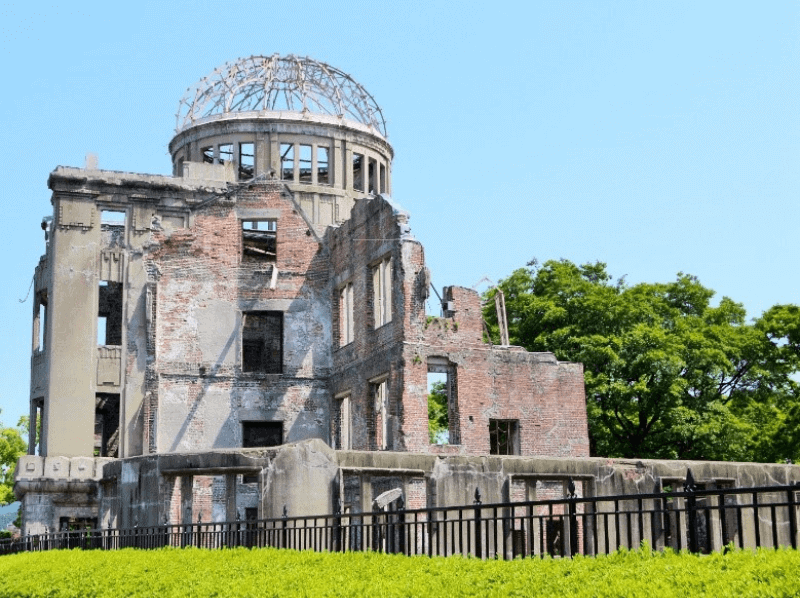
If you travel to Japan, one of the places you must see is the city of Hiroshima. It’s very beautiful, with many fun things to do and delicious local cuisine, but the historical significance is what makes Hiroshima worth visiting.
We toured this incredible city and were charmed by its strong resilience and ability to bounce back from the atomic bombing in August 1945. Our experience was educational, inspiring, and somber.
After exploring Hiroshima city, we also visited the island of Miyajima, which is a worthwhile add-on if you’re in the area.
Here are the highlights from our visit along with some tips and recommendations to help you make the most of your time in the Hiroshima area.
Contents (click to expand)
Day Trip to Hiroshima and Miyajima
Hiroshima is the 11th largest city in Japan, with a population close to 1.2 million people. Hiroshima and nearby Miyajima Island (also known as Itsukushima Island) are home to two of Japan’s 17 United Nations Educational, Scientific, and Cultural Organization (UNESCO) World Heritage Sites. It is no small wonder that this area is an important destination for tourists and historians alike.
| Related Reading: The Best Travel Guides for Japan
There are many things to do in Hiroshima, but we only had one day to explore. We visited the World War II memorials and then took a ferry from Hiroshima to Miyajima Island. Following is a short summary of our Hiroshima itinerary. You can find the logistical details at the end.
Hiroshima Peace Memorial Park
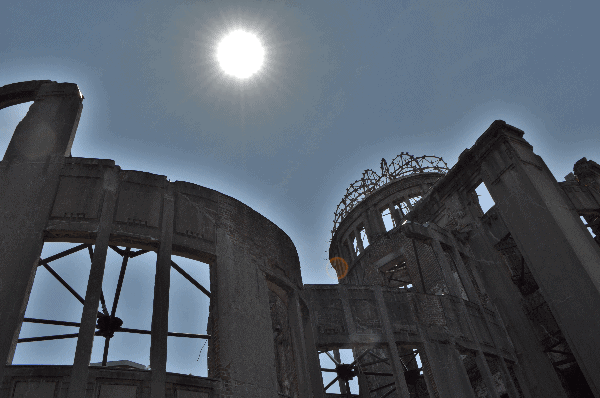
The Hiroshima Peace Memorial Park is located near “ground zero” of the atomic bomb explosion. The park includes numerous important sites:
- Atomic Bomb Dome (the UNESCO World Heritage Site)
- Peace Bell
- Children’s Peace Monument
- Cenotaph (war memorial) for Atomic Bomb Victims
- Hiroshima Peace Memorial Museum
You can easily do a self-guided walking tour of the first four sites, which are clustered together in a beautiful park straddled by two rivers.
The Atomic Bomb Dome, formerly the Hiroshima Prefectural Industrial Promotion Hall, is the most easily-recognizable structure in Hiroshima. It has been very well-preserved, so it looks exactly as it did after the bombing. The other monuments are only a short distance away.
Depending on how much time you spend taking photos, reading the documentation, or for quiet reflection, a tour could take anywhere from 45 minutes to 2 hours.
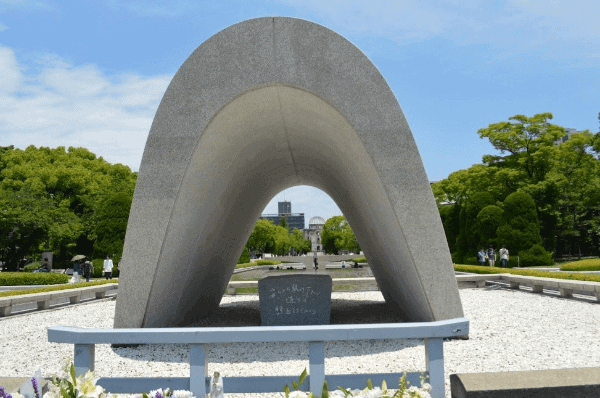
The Museum requires a bit more time. It is full of artifacts and stories of Hiroshima prior to, during, and after the atomic bomb. The museum offers a self-paced audio tour, which I recommend doing if you want to get the most out of your visit.
You may remember studying the Hiroshima bombing in school. But nothing can prepare you for the pictures, videos, charred remnants of victims’ belongings, and the sounds of people crying in the museum.
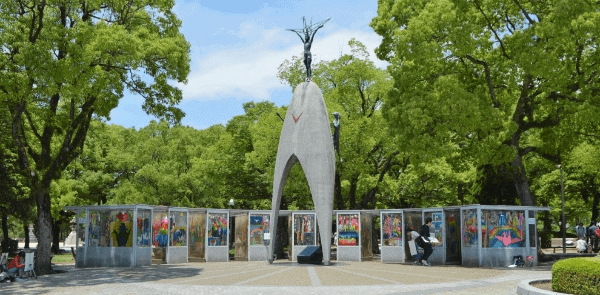
The atomic bomb exploded over the center of the city crowded with children, women, and elderly citizens going about their daily lives. When you stand on ground zero and see the destruction it caused to generations of people, it is a sobering sight.
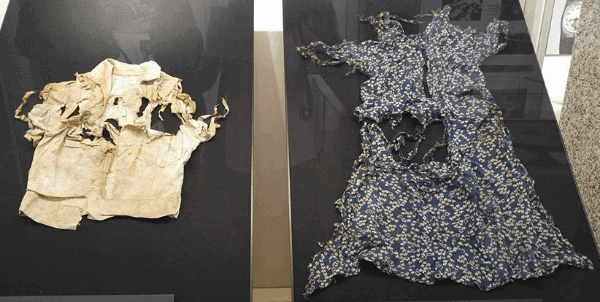
The city of Hiroshima has done an excellent job memorializing and telling the stories of the thousands of people who lost their lives as a result of the atomic bomb. Visiting the Peace Memorial Park will help you understand the stark reality of the destruction caused by nuclear weapons.
Miyajima Island & Itsukushima Shrine
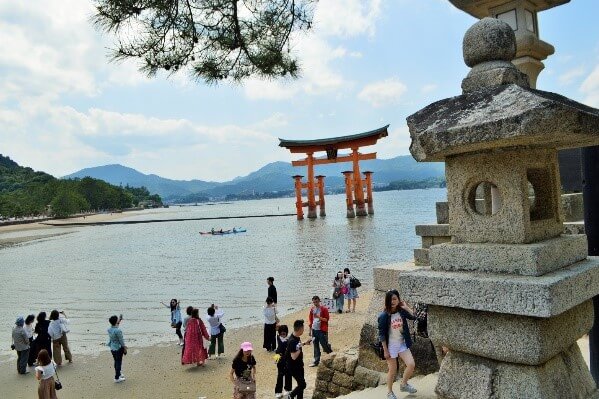
After our visit to the Hiroshima Peace Memorial Park, we visited the second UNESCO World Heritage Site, the Itsukushima Shrine on Miyajima Island.
This particular Shinto Shrine has the only Torii gate in the middle of the sea. (A “Torii” is a gate that marks the entrance to a Japanese Shinto shrine).
The first thing you may notice about the island is that there are deer everywhere. They are bold and friendly, and they may come up and try to nibble on your backpack or whatever you have in your hand.
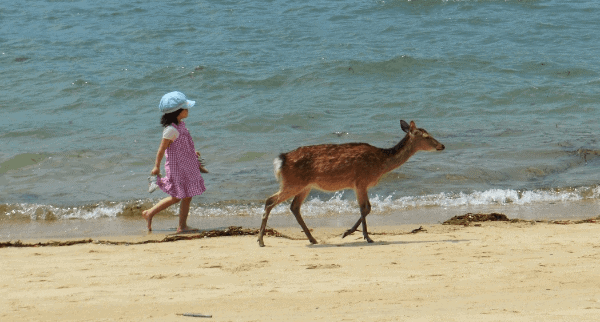
A short walk from the ferry terminal, you will see the famous orange Itsukushima Shrine Torii gate about 200 meters offshore. At high tide, the gate appears to be floating in the sea. At low tide, you can walk out to see the gate up close.
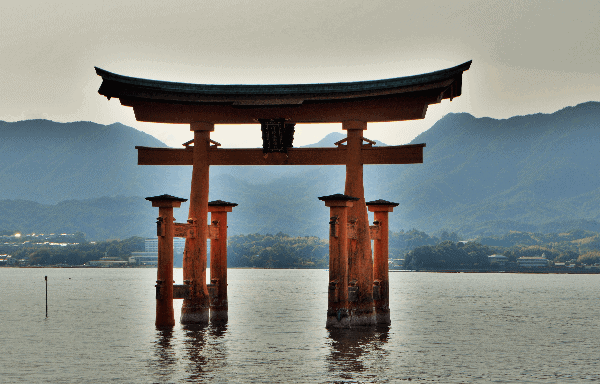
The main part of the shrine is also surrounded by water at high tide, but it’s located much closer inland. You can walk the corridors, which have no doors or walls. The entire shrine complex is designed to be in balance with the nature surrounding it.
After visiting the shrine, you may pass by the 5-Story Pagoda, another impressive site on Miyajima. From there, you can hike or take the ropeway (gondola) to the top of Mt. Misen, the highest peak on Miyajima.
We took the gondola as far as it went, but we still had to walk about a mile to the observatory at the highest point. The trail is rocky and a little bit steep in places, so make sure you have good footwear.
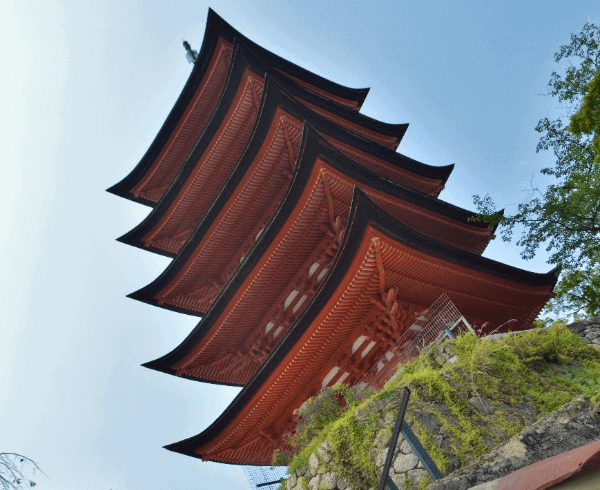
The trek is well worth the effort, because at the top, you will enjoy the reward of incredible 360 degree views of Hiroshima Bay. The picture speaks for itself.

While on Miyajima, you will also want to sample all of the delicious regional food, including Hiroshima-style okonomiyaki, oysters, steamed Hiroshima beef buns, and traditional sweets!
How Many Days You Need to Visit Hiroshima and Miyajima?
We were on a tight schedule and packed everything into one day. While we hit the most important highlights, I recommend allowing at least 2 days to tour Hiroshima and Miyajima.
Hiroshima is a dynamic city with many other things to do besides visit the atomic bomb memorials. Among the most popular attractions are Hiroshima Castle (also called Carp Castle) and Shukkeien Garden. It’s also a fun place to simply walk around, do some shopping, and sample all the local cuisine!
You could also spend a full day exploring Miyajima. The island has beautiful beaches, delicious food, hikes of varying difficulty, and an aquarium. You may also want to stick around to see the beautiful Torii gate at night.
Logistics
Here’s what you need to know to plan your visit to Hiroshima and Miyajima.
When to Go
We visited in June, and it was pleasant, albeit a bit warm, especially during our hike up Mt. Misen.
If you have a flexibility, the best time to visit Hiroshima is either during cherry blossom season (the cherry blossoms, or sakura, usually bloom in late March/early April), or in autumn, when you can enjoy the beautiful fall colors.
Also, every year on August 6th (the anniversary of the bombing), the city of Hiroshima holds a Peace Memorial Ceremony. The ceremony starts at 0800, so if you want to join the locals in paying silent tribute to the victims of the bomb, plan your visit accordingly.
Where to Stay
If you stay in Hiroshima overnight, there are many reasonably-priced hotels and guests houses within easy walking distance of the Peace Memorial Park. Click here to explore your options and check rates.
You can also stay right on Miyajima if you want to see the island at night and don’t want to worry about ferry schedules. Miyajima has a limited number of hotels ranging from simple guest houses to 5-star ryokans (Japanese-style inns). Click here to explore Miyajima hotels.
Getting to Hiroshima
The best way to get to Hiroshima is by train. Hiroshima Station is located in the middle of the city, only a few streetcar stops or a pleasant 20-minute walk from the Peace Park. Hiroshima airport is about 45 minutes outside the city.
| Get your Japan Rail (JR) pass here!
We rented a car and drove from Fukuoka. It was convenient because we were making other stops along the way, but it proved to be rather expensive when we added the cost of tolls and parking to the daily rental fee.
Visiting Hiroshima Peace Memorial Museum
The museum is open every day of the year except for December 30 and 31. It opens at 08:30. Closing times vary, depending on the time of year.
Admission is only 200 yen (about $2) for adults, 100 yen for seniors 65+ and high school students, and free for younger children. The audio guide is 200 yen. The museum does not take reservations.
Getting to Miyajima
We traveled to Miyajima by high-speed ferry. The dock for the World Heritage Sea Route was conveniently located next to the Peace Memorial Park and cost about $36 round trip per person for the scenic 45-minute trip. We purchased our tickets on-site at the vending machine.
For about half the price, you can take the streetcar + train from Hiroshima Station to Miyajimaguchi Station and then take a short ferry to the island, but it will add a good 30 minutes to your travel time. You can use your Japan Rail pass for both the train and the ferry (but not for the World Heritage Sea Route).
Plan Your Hiroshima Itinerary
A trip to Japan is not complete without a visit to Hiroshima. While you can tour the atomic bomb memorials and travel to Miyajima Island in one day, I recommend spending at least 2 days in the area.
Between the history, culture, natural beauty, and delicious food, there are so many things to do in Hiroshima and Miyajima that you won’t want to rush your visit. Build the extra time into your Japan itinerary; you won’t regret it!
Related Reading
Want more information and ideas for your trip to Japan? Here are other articles you will like:
Pro Tips for Using Airbnb in Japan

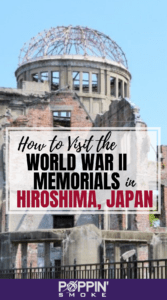
Hi Stephanie and Mike. Thank you for a great article.
My wife and I are Australian and eager travellers who have now “retired” at a fairly young age .. (a bit like yourselves).
We met Mike in a coffee shop in Fukuoka and he told us about your site.
We’re pretty jealous of what is available to ex-military US staff however I get why it’s available and I can also see the context is … how to live a life in retirement and explore the planet.
I look forward to more interviews and blog posts.
I look forward to using your site as a tool to expand what we see as possible in retirement whether ex-US Military or not.
Cheers
Benj
Thanks Benj! Glad to have you as a reader!
If you are lucky enough to go to Miyajima Island, while there you should try their famous oysters if they are in season. We had them grilled and they were wonderful. The general rule of thumb seems to be that you eat oysters during months that have an “R” in the name. Also, there is a shuttle bus that takes you from behind the shrine up to the start of the ropeway. If you use it, it will save you a lot of uphill walking!
Thanks Wayne! That’s a good tip about the shuttle bus. I’m going back to Miyajima next month when my niece visits!
Thanks, Stephanie and Mike. This was a great read and will definitely help me plan my trip to Hiroshima in a few months. Appreciate your insights. Cheers!
Thanks Eddie! We look forward to hearing about your trip!